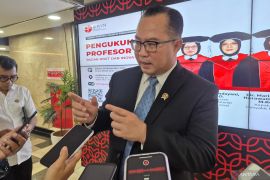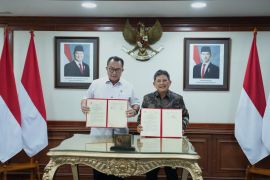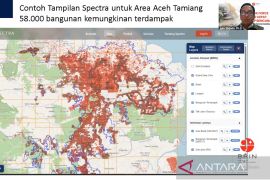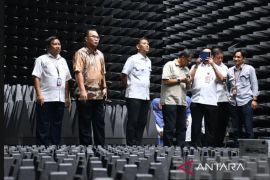This situation forces humankind to immediately switch from unsustainable energy sources to cleaner and renewable green energy.
Science is a guide for humans to save the Earth through alternative, environmentally friendly energy. Head of the National Research and Innovation Agency (BRIN) Laksana Tri Handoko stated that the development of new and renewable energy requires serious efforts not only from the government and energy management but also technological breakthroughs.
“That is our challenge, especially in the research and academic community, to find ways to achieve new and renewable energy (development) amid the geopolitical situation,” he remarked in early June of 2024.
Scientists are artists. Research and innovation activities enable humans to be creative and open up opportunities for the development of an environmentally friendly energy industry.
On an Earth with a population reaching eight billion people, alternative energy holds the key to a better life in the future.
Fuel replacement
The Ministry of Energy and Mineral Resources (ESDM) recorded that in the last decade, new and renewable energy has experienced quite significant growth, slowly replacing fossil energy.
Based on data from the Handbook of Energy and Economic Statistics of Indonesia 2023, published by the ESDM Ministry on June 6, 2024, the supply of fossil energy in the form of oil, coal, and natural gas reached 41.43 percent, 29.61 percent, and 22.28 percent, respectively, in 2013.
A decade later, in 2023, the share of fossil fuels in the national primary energy mix dipped to 29.91 percent of oil and natural gas with 17.11 percent. Meanwhile, the share of coal was recorded to have grown to 39.69 percent due to the 35 thousand megawatt project focused on steam power plants (PLTU).
In 2013, the share of new and renewable energy in national primary energy only amounted to 6.69 percent, followed by an increase to 13.29 percent of green energy in 2023.
The global determination to suppress climate change by reducing carbon emissions from power plants creates new opportunities for environmentally friendly green electricity.
Although Indonesia has abundant new and renewable energy resources, such as sun, wind, and water, the most promising alternative energy sources are biofuels and nuclear.
Although Indonesia is a tropical country that receives 12 hours of sunlight throughout the year, BRIN sees that the efficiency of solar panels in Indonesia is lower than in subtropical countries in Australia and the Middle East.
The amount of cloud cover in Indonesia can hinder the production of electricity from solar panels. After all, Indonesia is an archipelagic country that quickly forms clouds.
Large-scale solar electricity is unsuitable in Indonesia since it takes up a lot of land. However, independent and small-scale solar panels for public street lighting are considered ideal in Indonesia.
Wind power is also considered less effective in Indonesia, which has a monsoon climate. Wind power is generally efficient for subtropical countries where wind pressure is consistent.
"Scientifically speaking, we know that solar and wind are more challenging in Indonesia as compared to other countries. Do we encourage biofuels? With hydroelectric power plants, it will also be difficult since it can damage the environment,” Handoko explained.
Currently, his side is conducting a research project to boost the potential of plantations and agriculture to produce biofuels.
Crude palm oil, sorghum, and corn can be substitute fuels for the transportation sector. In 2013, the share of biofuels in primary energy was only 0.56 percent. A decade later, the percentage share of biofuel was recorded at 4.54 percent.
Indonesia has, in fact, established technology to produce biofuel and is supported by large plantations and agricultural areas.
A researcher at the BRIN Energy Conversion and Conservation Research Center, Rizal Alamsyah, stated that the technology for processing biomass into biofuels—liquid and solid products— has progressed.
The conversion of biomass into energy can be carried out in several ways, namely direct combustion conversion, thermochemical conversion, and biochemical conversion.
Nowadays, liquid biofuel technology has developed rapidly, from the first generation, which used primary raw materials, to the third generation, which uses aquatic plant biomass. In fact, biofuel technology has currently entered the fourth generation that converts biomass into biohydrogen.
Scientists left traces for future civilizations with the works they carved on the pages of scientific books. The goal is for humanity to continue to explore, think, and innovate.
Proper technology
Batteries play an important role in determining the future of new and renewable energy. Half of the challenges faced in green electricity implementation can be resolved with the development of battery technology.
Humanity can store as much energy as possible in storage space without taking too much space.
In daylight, solar panels convert the sun's rays into electricity and then store it in batteries for night-time use. This concept is similar to that applied to wind power plants.
So far, nuclear power has become the most sensible option for producing electricity without continued production of carbon emissions.
In 1958, Indonesia was the first country to own a nuclear reactor on the Asian continent. However, Indonesia is now far behind other countries, such as the United Arab Emirates, which already has four nuclear power plants (PLTN).
In the New Energy and Renewable Energy Bill (RUU EBET) that has been completed and will soon be published, the government places nuclear as one of the energy sources in the future.
Nuclear technology for electricity is considered mature by reaching the fourth generation of nuclear reactor technology.
According to scientists, this fourth-generation reactor is the most suitable for development in Indonesia, as it is safe, has a high-temperature gas cooling system, and is affordable and low waste.
Despite being a mature technology and one of the most potential energy sources, nuclear power is not always popular in several countries, including Indonesia.
The level of public acceptance—remembering the nuclear tragedies at Chernobyl and Fukushima—remains a challenge in nuclear development not only in Indonesia but also in developed countries.
If history always weighs heavily, we may never be ready to face the various possibilities in the future. History has provided lessons for a better human life in the future through serious efforts.
Related news: BRIN outlines development plans for nuclear power plant in Indonesia
Related news: Indonesia, Finland bolster cooperation in green energy, smart cities
Editor: Rahmad Nasution
Copyright © ANTARA 2024












